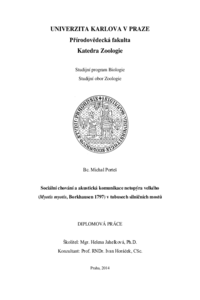Sociální chování a akustická komunikace u netopýra velkého (Myotis myotis)
Social behaviour and acoustic communication in greater mouse-eared bat (Myotis myotis)
diploma thesis (DEFENDED)

View/
Permanent link
http://hdl.handle.net/20.500.11956/68025Identifiers
Study Information System: 130859
Collections
- Kvalifikační práce [20357]
Author
Advisor
Consultant
Horáček, Ivan
Referee
Bartonička, Tomáš
Faculty / Institute
Faculty of Science
Discipline
Zoology
Department
Department of Zoology
Date of defense
17. 9. 2014
Publisher
Univerzita Karlova, Přírodovědecká fakultaLanguage
Czech
Grade
Excellent
Keywords (Czech)
Chiroptera, systém párování, vokalizace, chování, tvorba harémů, dálniční mostyKeywords (English)
Chiroptera, mating system, vocalization, behaviour, harem formation, higway bridgesV rámci řádu letounů (Chiroptera) existuje velká variabilita v potravních, úkrytových i sociálních strategiích. Netopýr velký (Myotis myotis, Borkhausen 1797) je modelovým druhem netopýrů v rámci Evropy a jeho sezónní organizace odpovídá cyklu mírného pásma s velkými mateřskými koloniemi a solitérním životem samců. Přestože se jedná o modelový druh, většina prací je věnována různým aspektům biologie mateřských kolonií a biologie samců je málo známá. Nedávné nálezy samčích agregací v silničních mostech tak umožňují studovat sociální chování a akustickou komunikaci samců na individuální úrovni a porovnávat je s dosavadními znalostmi. Zatímco most v Bernarticích byl osídlen seskupením samců, ve Voznici byla zjištěna i mateřská kolonie. Formování harému probíhalo od srpna do října. Pattern osídlení úkrytů samců se lišil a samci s nejvyšší úrovní sezónní obsazenosti úkrytu měli největší přítomnost samice v úkrytu. Vokalizační aktivita samců narůstala v srpnu a nejvyššími hodnotami v září. Nejvyšší vokalizační aktivitu měli samci sídlící v blízkosti vletového otvoru. Sociální signál M. myotis je tvořen 4 základními motivy, jež samci kombinují a je typicky emitován jako reakci na prolétávajícího jedince. Na základě akustické analýzy lze rozlišit interindivuální rozdíly v parametrech signálů. Získané...
Order Chiroptera is characterized by great variability in foraging, roost and social strategies. Greater mouse-eared bat (Myotis myotis, Borkhausen 1797) is a model species of a bat in Europe and his seasonal organisation of population represents typical temperate bat cycle with females aggregated in large maternity colonies and solitery roosting males. Although the M.myotis is a model species, the majority of studies were focused on different aspects of maternity colonies biology and the biology of males is still poorly known. Recently founded aggregations of males of M. myotis in highway bridges allow to study social behaviour and acoustic communication of males on between individual level and discuss these findings with known information. While the bridge in Bernartice was inhabited by aggregation of males in individual roosts, in Voznice bridge we found besides males also a maternity colony of M. myotis. Harems of males were established from august until october. We found different pattern of seasonal roost occupancy in males with males with the highest level of mean occupancy having the highest level of female presence in roost. Vocalisation activity of males increased in august with highest level of activity in september. Males roosting closer to the flight entrance tended to have higher...
